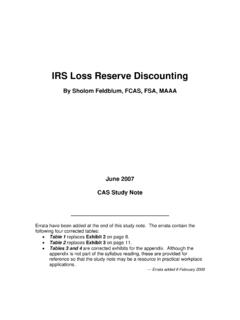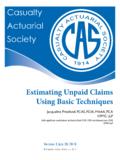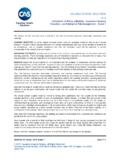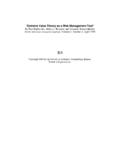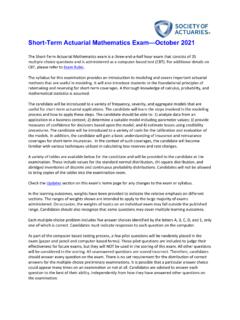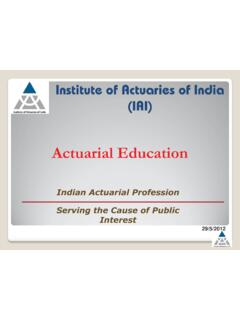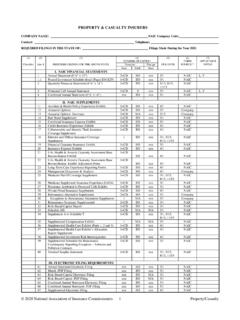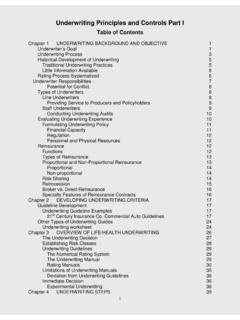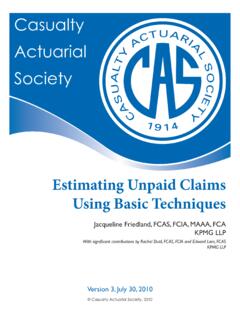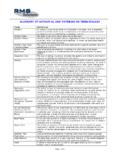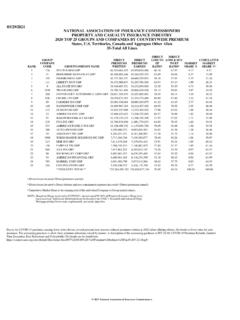Transcription of Chapter 7 REINSURANCE - Casualty Actuarial Society
1 Job no. 1971casualty Actuarial societyCAS Textbook1971CH07 [1]08-21-013:43 pmChapter 7 REINSURANCEGARY S. PATRIKINTRODUCTIONWhat is REINSURANCE ? REINSURANCE is a form of insurance. A REINSURANCE contract islegally an insurance contract. Thereinsureragrees to indemnifythecedantinsurer for a specified share of specified types of in-surance claims paid by the cedant for a single insurance policyor for a specified set of policies. The terminology used is thatthe reinsurerassumesthe liabilitycededon thesubject , or share of claims to be paid by the reinsurer, maybe defined on aproportional sharebasis (a specified percentageof each claim) or on anexcess basis(the part of each claim, oraggregation of claims, above some specified dollar amount).
2 The nature and purpose of insurance is to reduce the finan-cial cost to individuals, corporations, and other entities arisingfrom the potential occurrence of specified contingent events. Aninsurance company sells insurance policies guarantying that theinsurer will indemnify the policyholders for part of the financiallosses stemming from these contingent events. The pooling ofliabilities by the insurer makes the total losses more predictablethan is the case for each individual insured, thereby reducingthe risk relative to the whole. Insurance enables individuals, cor-porations and other entities to perform riskier operations. Thisincreases innovation, competition, and efficiency in a nature and purpose of REINSURANCE is to reduce the fi-nancial cost to insurance companies arising from the potentialoccurrence of specified insurance claims, thus further enhancinginnovation, competition, and efficiency in the marketplace.
3 Thecession of shares of liability spreads risk further throughout the343job no. 1971casualty Actuarial societyCAS Textbook1971CH07 [2]08-21-013:43 pm344 REINSURANCECh. 7insurance system. Just as an individual or company purchases aninsurance policy from an insurer, an insurance company may pur-chase fairly comprehensive REINSURANCE from one or more rein-surers. A reinsurer may also reduce its assumed REINSURANCE riskby purchasing REINSURANCE coverage from other reinsurers, bothdomestic and international; such a cession is called companies are of two basic types:direct writers,which have their own employed account executives who producebusiness, andbroker companiesorbrokers, which receive busi-ness throughreinsurance intermediaries.
4 Some direct writers doreceive a part of their business through brokers, and likewise,some broker reinsurers assume some business directly from theceding companies. It is estimated that more than half of is placed via form and wording of REINSURANCE contracts are not asclosely regulated as are insurance contracts, and there is no rateregulation of REINSURANCE between private companies. A rein-surance contract is often a manuscript contract setting forth theunique agreement between the two parties. Because of the manyspecial cases and exceptions, it is difficult to make correct gen-eralizations about REINSURANCE . Consequently, as you read thischapter, you should often supply for yourself the phrases It isgenerally true that::: and Usually::: whenever they are notexplicitly heterogeneity of contract wordings also means thatwhenever you are accumulating, analyzing, and comparing var-ious REINSURANCE data, you must be careful that the reinsurancecoverages producing the data are reasonably similar.
5 We will beencountering this problem throughout this Functions of ReinsuranceReinsurance does not change the basic nature of an insurancecoverage. On a long-term basis, it cannot be expected to makejob no. 1971casualty Actuarial societyCAS Textbook1971CH07 [3]08-21-013:43 pmINTRODUCTION345bad business good. But it does provide the following direct as-sistance to the REINSURANCE coverage, a cedant can write higher pol-icy limits while maintaining a manageable risk level. By cedingshares of all policies or just larger policies, the net retained lossexposure per individual policy or in total can be kept in line withthe cedant s surplus. Thus smaller insurers can compete withlarger insurers, and policies beyond the capacity of any singleinsurer can be word capacity is sometimes also used in relation to ag-gregate volume of business.
6 This aspect of capacity is best con-sidered below in the general category of financial results can help stabilize the cedant s underwriting andfinancial results over time and help protect the cedant s sur-plus against shocks from large, unpredictable losses. Reinsur-ance is usually written so that the cedant retains the smaller,predictable claims, but shares the larger, infrequent claims. Itcan also be written to provide protection against a larger thanpredicted accumulation of claims, either from one catastrophicevent or from many. Thus the underwriting and financial effectsof large claims or large accumulations of claims can be spreadout over many years. This decreases the cedant s probability offinancial Results ManagementReinsurance can alter the timing of income, enhance statutoryand/or GAAP surplus, and improve various financial ratios bywhich insurers are judged.
7 An insurance company with a grow-ing book of business whose growth is stressing their surplus cancede part of their liability to a reinsurer to make use of the rein-surer s surplus. This is essentially a loan of surplus from thejob no. 1971casualty Actuarial societyCAS Textbook1971CH07 [4]08-21-013:43 pm346 REINSURANCECh. 7reinsurer to the cedant until the cedant s surplus is large enoughto support the new business. We will see other ways that rein-surance can be used to alter a cedant s financial numbers. Asyou might expect in a free market, this aspect of reinsurancehas led to some abuses in its use. As we discuss the variousforms of REINSURANCE coverage, we will note their financial AdviceMany professional reinsurers have the knowledge and abilityto provide an informal consulting service for their cedants.
8 Thisservice can include advice and assistance on underwriting, mar-keting, pricing, loss prevention, claims handling, reserving, actu-arial, investment, and personnel issues. Enlightened self-interestinduces the reinsurer to critically review the cedant s operation,and thus be in a position to offer advice. The reinsurer typicallyhas more experience in the pricing of high limits policies andin the handling of large and rare claims. Also, through contactwith many similar cedant companies, the reinsurer may be ableto provide an overview of general issues and trends. Reinsuranceintermediaries may also provide some of these same services fortheir Forms of ReinsuranceFacultative CertificatesA facultative certificate reinsures just one primary policy.
9 Itsmain function is to provide additional capacity. It is used tocover part of specified large, especially hazardous or unusualexposures to limit their potential impact upon the cedant s netresults or to protect the cedant s ongoing ceded treaty results inorder to keep treaty costs down. The reinsurer underwrites andaccepts each certificate individually; the situation is very simi-lar to primary insurance individual risk underwriting. Becausefacultative REINSURANCE usually covers the more hazardous or un-usual exposures, the reinsurer must be aware of the potential forantiselection within and among classes of no. 1971casualty Actuarial societyCAS Textbook1971CH07 [5]08-21-013:43 pmINTRODUCTION347 Property certificate coverage is sometimes written on a pro-portional basis; the reinsurer reimburses a fixed percentage ofeach claim on the subject policy.
10 Most Casualty certificate cover-age is written on an excess basis; the reinsurer reimburses a share(up to some specified dollar limit) of the part of each claim onthe subject policy that lies above some fixed dollar attachmentpoint(netretention).Facultativ e Automatic Agreements or ProgramsA facultative automatic agreement reinsures many primarypolicies of a specified type. These policies are usually very sim-ilar, so the exposure is very homogeneous. Its main function isto provide additional capacity, but since it covers many policies,it also provides some degree of stabilization. It may be thoughtof as a collection of facultative certificates underwritten simulta-neously. It may cover on either a proportional or excess basis. Itis usually written to cover new or special programs marketed bythe cedant, and the reinsurer may work closely with the cedantto design the primary underwriting and pricing guidelines.

